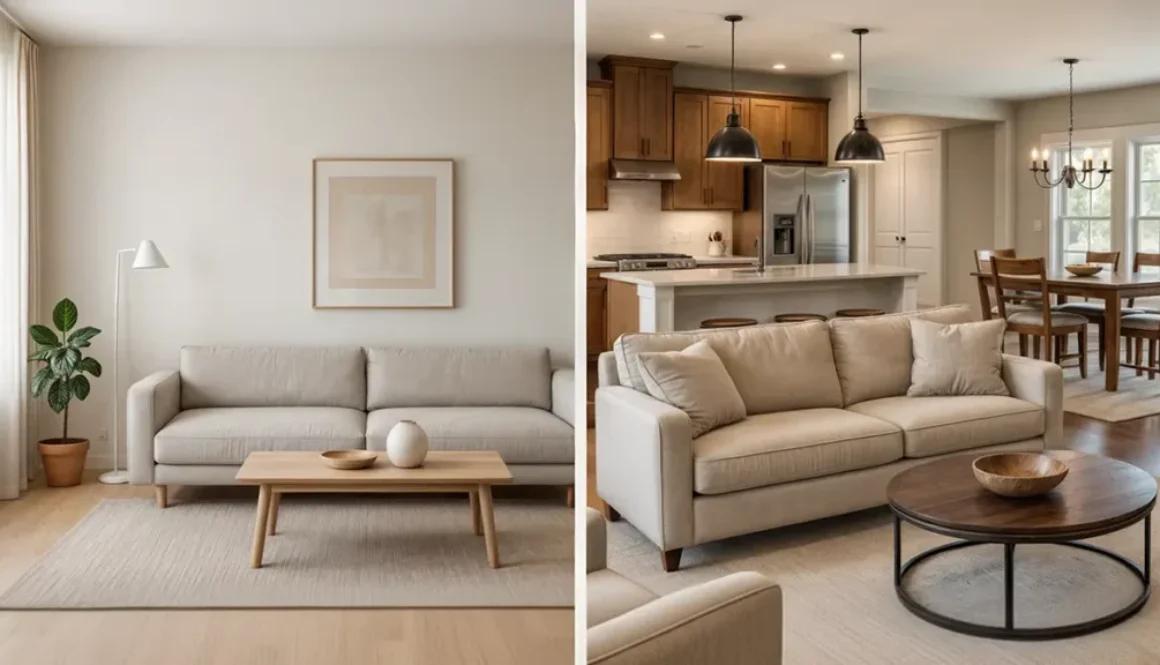European vs American Interior Design: Key Differences in 2025
Ever walked into a home and instantly felt the difference between European sophistication and American expansiveness? These European vs American interior design differences are not limited to aesthetics. They reflect centuries of cultural evolution, resource availability, and lifestyle priorities.
Table of Contents
What Differentiates European Home Design from American Design
As a European architect and interior designer now working with American clients, I see clear differences in how Europe and America approach interior design.
I’ve noticed these distinctions become both more pronounced and more fluid as global design influences spread through social media.
Why European vs American Interior Design Differences Matter
Understanding these differences provides insights for creating your perfect home, regardless of which continent you actually call home.
For example:
- European efficiency can bring purpose to large American spaces.
- American creativity can add vibrant life to European minimalism.
Let’s compare American and European interior design styles in more detail.
Space & Architecture: Efficiency vs. Expansiveness
Europeans Are Making Every Inch Count
With homes typically 60% smaller than their American counterparts, European designs prioritize multi-functionality and clever storage solutions.
In European cities, buildings often date back centuries.
Residents have adapted to smaller footprints by embracing built-in furniture, transformable pieces, and innovative spatial planning.
European designers think vertically.
We utilize wall space for storage to keep floor areas clear and uncluttered.
Even in modern European constructions, this efficiency mindset persists. It’s not from necessity, but from a cultural value placed on purposeful living.
European houses also feature distinctive architectural elements like higher ceilings with decorative moldings, even in modest homes.
These ceiling treatments add character without consuming floor space.
They perfectly demonstrate the European knack for maximizing aesthetic impact in compact areas.
American Homes Celebrate Spaciousness
With the luxury of land availability, American home interior design evolved around open-concept layouts. The living, dining, and kitchen areas blend seamlessly.
Larger homes (averaging 2,200 square feet (204.39 m²) compared to Europe’s 1,027 square feet (95.41 m²)) allow for dedicated single-purpose rooms:
- formal dining rooms,
- home offices,
- media rooms, and
- spacious walk-in closets.
American design often values how big a space looks more than how well it uses storage. Furniture is usually set up to make a space feel open, not to maximize functionality.
European homes are generally smaller due to higher urban density, limited land availability, and centuries of development in established cities with historical constraints.
While still more than double the size of European homes, US houses have been shrinking slightly from their 2015 peak of 2,500 sq ft to a median of 2,140 sq ft for newly constructed homes in 2024.
My Insights
Considering European vs American interior design, I find that mixing European and American ideas about interior design makes the best rooms.
Planning a room like Europeans do can show hidden potential in American homes. It can make spaces feel big and well-planned – the best parts of both styles.
For example, applying European principles to create a minimalist luxury living room in an American home maintains the spaciousness Americans love while adding functionality.
Energy Efficiency: Integration vs. Addition
European Homes
Energy efficiency is a foundational principle in European design.
European homes usually have thick walls, good insulation, and windows with two or three layers of glass. Instead of forced air, radiators warm houses steadily using less energy. Houses are built to get the most sunlight and warmth from the sun.
In European countries, design also focuses on “thermal zoning” – heating only the rooms being used, not the whole house. Each room has its own heating controls to do this.
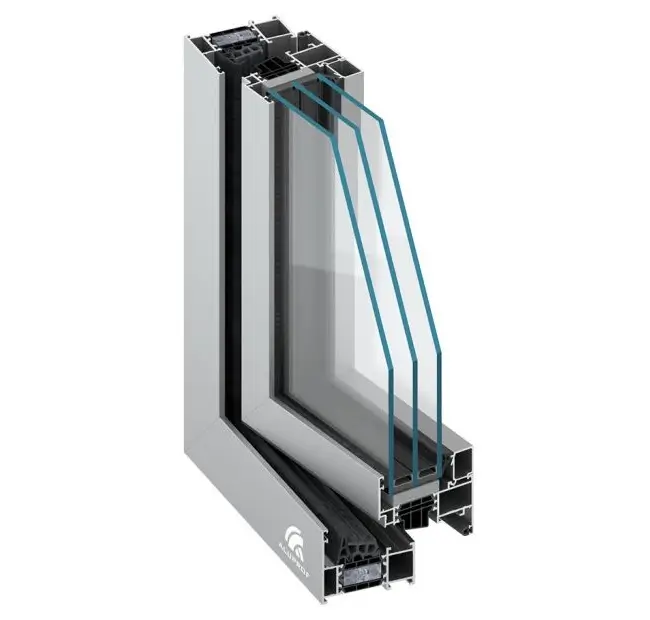
The American Way of Saving Energy
Energy efficiency in American homes has historically been more optional than essential, but this is rapidly changing.
Lately, we’re seeing a significant shift toward eco-conscious design thinking. 43% of American designers now expect sustainability requirements in their projects.
This is an emerging priority, unlike the long-established necessity it has been in Europe.
In American homes, saving energy usually means adding new tech to a regular building.
New houses in America do use more eco-friendly features.
But they’re usually added onto traditional building methods, instead of making them part of the plan from the start. HVAC systems are powerful but often prioritize immediate comfort over long-term efficiency.
Because American homes are big, they naturally require more energy to maintain comfortable temperatures. This makes it hard to save energy, no matter what tech they use.
My Insights
In my practice, we bring European energy awareness to American projects.
I focus first on passive design elements—orientation, insulation, and window placement—before adding active technologies.
This approach creates homes that are energy-efficient, comfortable, and economical to maintain.
The European approach of building efficiency into the core design offers valuable lessons for American projects. This becomes even more important as energy costs and environmental awareness increase.
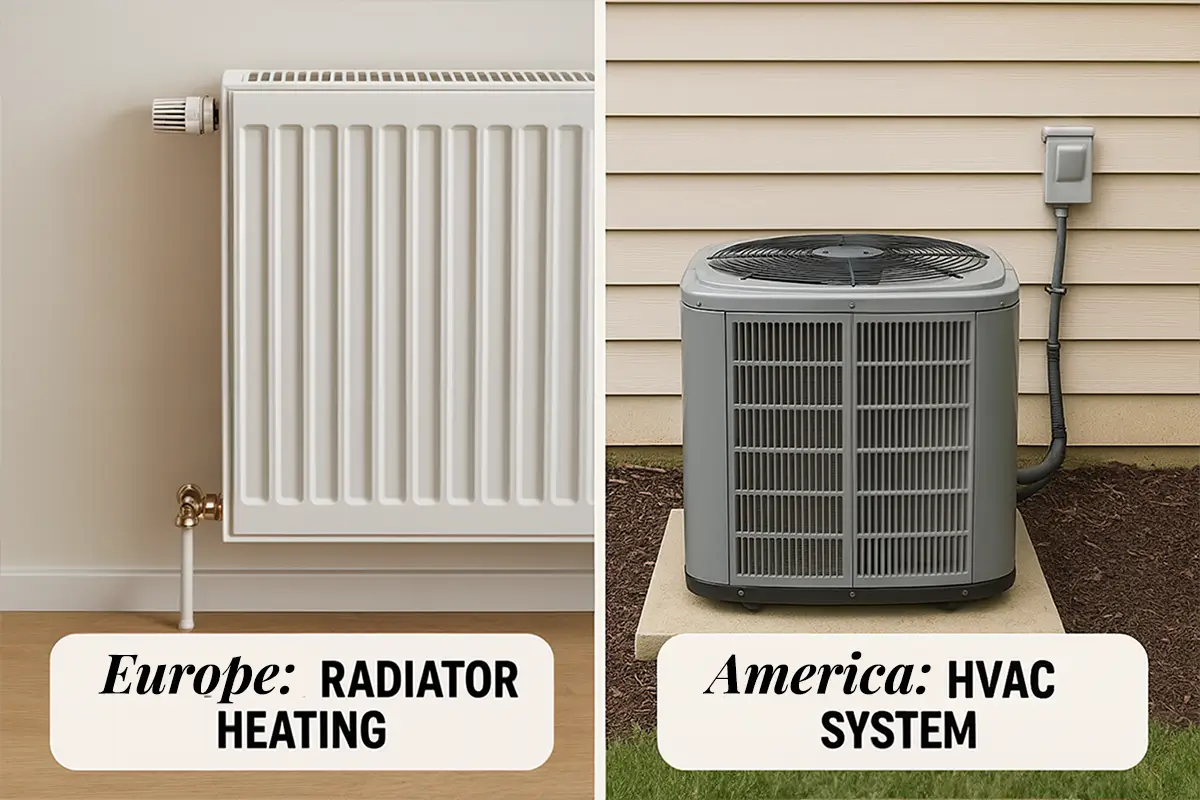 European vs American interior design: A traditional American living room with elaborate wooden wall paneling, coffered ceiling, and formal furniture arrangement – demonstrating American preference for detailed architectural elements and classic styling.
European vs American interior design: A traditional American living room with elaborate wooden wall paneling, coffered ceiling, and formal furniture arrangement – demonstrating American preference for detailed architectural elements and classic styling.
Functionality: Practicality vs. Personalization
European functionality
European interiors prioritize practicality, durability, and longevity.
Europeans choose furniture based on how well it serves its purpose over time.
European kitchens show this through their small but very effective layouts.
Smaller appliances, built-in storage, and good use of space show a way of life where cooking is valued as a daily ritual.
American Personalization and Comfort
American design places greater emphasis on personalization and comfort.
Furniture tends to be larger and more plush.
It prioritizes immediate comfort over space efficiency or longevity.
The typical American kitchen features larger appliances, extensive counter space, and often includes gathering areas.
This reflects its role as a social hub rather than just a cooking space.
American design philosophy also embraces change. Homeowners are more likely to redecorate or renovate as tastes and trends evolve.
My Insights
My best designs blend European functionality with American comfort.
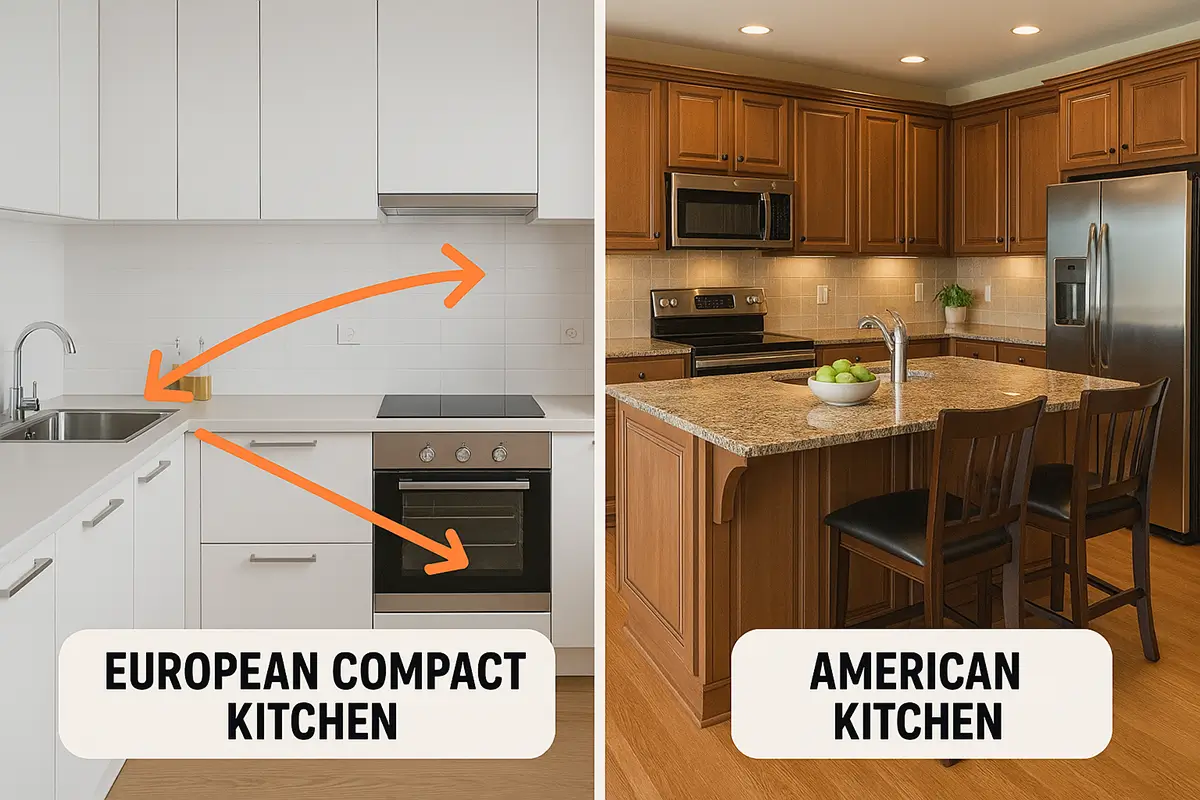
Minimalism and Decor: Discipline vs. Expression
Another noticeable difference between American and European homes is in their approach to Minimalism.
European Minimalism and Home Decor
European minimalism stems from both necessity and aesthetic discipline.
This restraint extends to color palettes.
With smaller homes, Europeans have learned to choose their things carefully. “Less is more” means more than just looking simple. It shows a way of life that puts importance on good things, not lots of things.
This restraint also applies to colors.
Europeans often favor neutral backgrounds with carefully chosen accent colors that add warmth without visual clutter.
In the bedroom, European design prioritizes calm and tranquility with warm minimalist bedroom approaches that eliminate clutter.
Similarly, bathrooms tend to be smaller but highly efficient, with space-saving fixtures and streamlined storage solutions.
American Approach to Minimalism and Decor
American homes often show bolder decorating.
They use greater variation in colors, patterns, and accessories.
People show off collections, memories, and things they own.
These create spaces that tell the homeowner’s story through visual elements.
Even when Americans adopt minimalism, they often make it more dramatic and bolder than Europeans.
American bedrooms and bathrooms tend to be significantly larger, with bathrooms often featuring spa-like amenities.
My Insights
European color discipline can provide valuable structure for even the most expressive American interiors.
If you use a calm set of base colors, personal items you love and bold designs stand out more.
They don’t have to compete with too many colors or patterns.
This balance makes homes feel personal and calm to look at.
It mixes the good parts of both worlds.
*If you have a passion for minimalist style, you can explore the latest trends in minimalist design here.
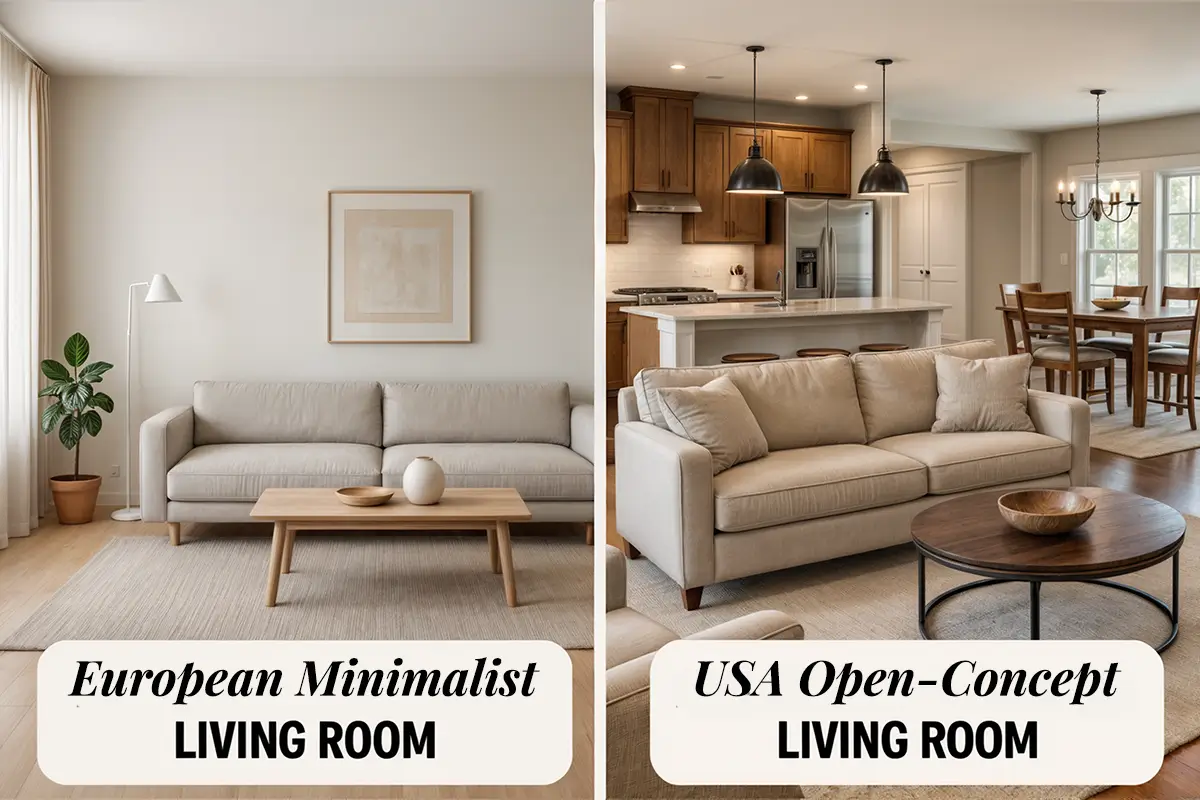 European vs American interior design: The striking contrast between a minimalist European living room (left) with carefully curated elements and an American open-concept design (right) that prioritizes spaciousness and connectivity to kitchen areas.
European vs American interior design: The striking contrast between a minimalist European living room (left) with carefully curated elements and an American open-concept design (right) that prioritizes spaciousness and connectivity to kitchen areas.Color Philosophy: Longevity vs. Expression
European Color Palettes
European color palettes tend toward sophistication and longevity over trend-driven choices.
According to recent design forecasts, Europeans are embracing rust green for walls and accessories in 2025/2026, with copper tones gaining popularity for their warmth and timelessness.
This reflects a European design philosophy that values lasting quality over frequent refreshes.
The European approach to color typically involves subtle layering of related tones rather than high-contrast statements.
Of course, there are notable regional variations:
Scandinavian countries favor lighter neutrals that maximize natural light during dark winters.
Mediterranean regions embrace warmer earth tones that complement the natural environment. A warm minimalist color palette is often employed throughout the home to create visual cohesion between rooms.
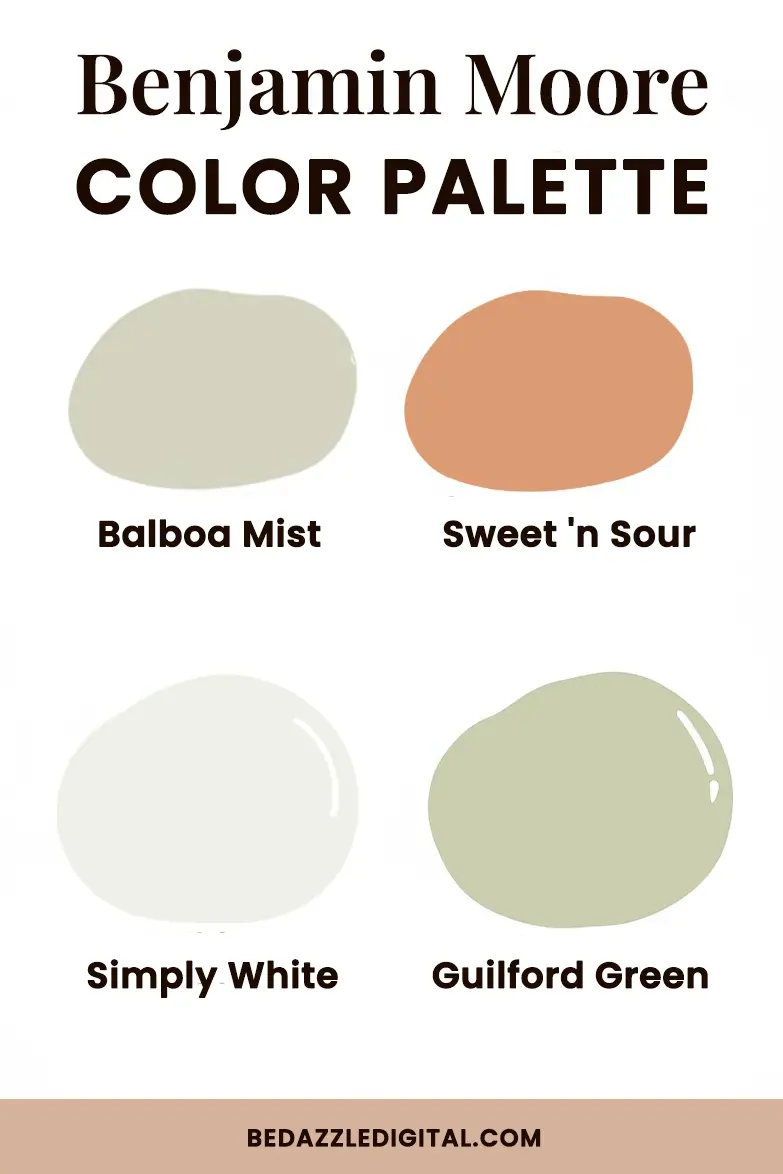
American Design Embraces Color as a Tool for Expression
American color preferences show more willingness to embrace bold statements and seasonal updates.
Deep burgundy is emerging as a prominent color in American interior design, alongside saturated greens and navy blue.
American designers and homeowners often view color as an accessible way to refresh spaces without major renovation.
Regional variations are also more pronounced in American homes.
From the bright coastal palettes of Florida to the earth tones of the Southwest, these reflect America’s diverse geography and cultural influences.
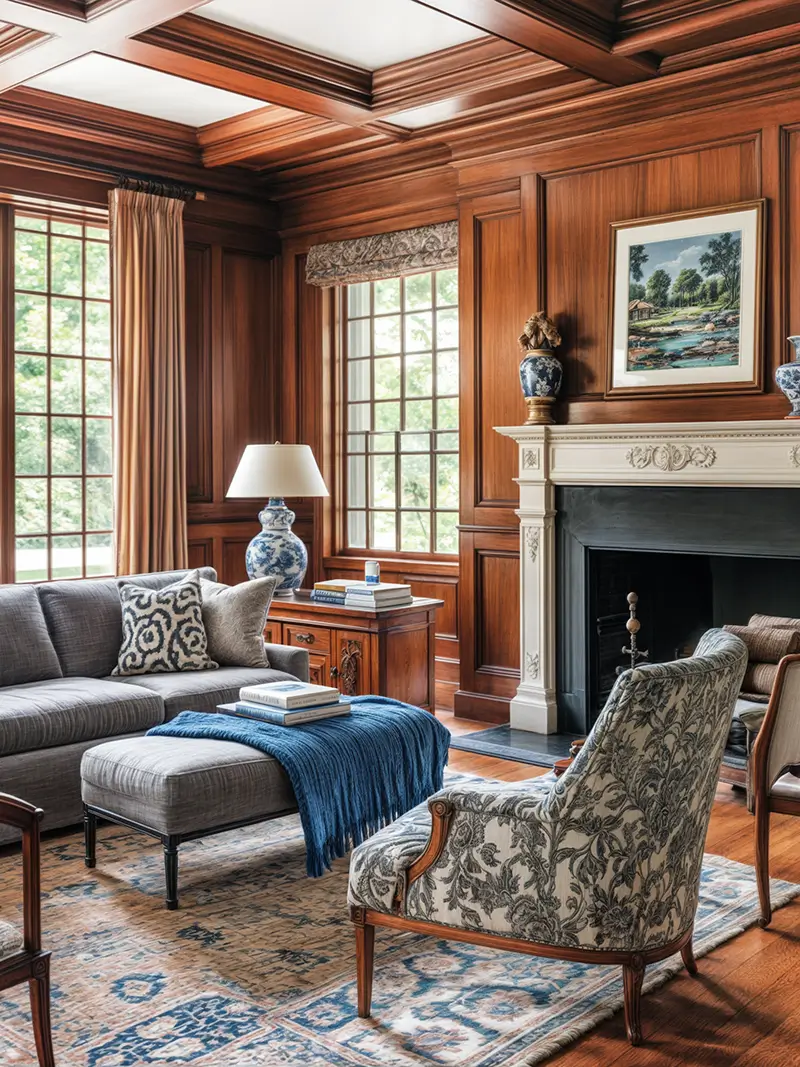
My Insights and Approach to Color
The most successful color approaches I develop blend European sophistication with American expressiveness.
A foundation of refined neutrals (the European influence) can provide the perfect backdrop for strategic color moments (the American touch) that reflect the homeowner’s personality.
For clients looking to create luxury living room ideas with lasting appeal, I often recommend this balanced color approach. It works great in both traditional and contemporary homes.
The Future: Convergence
As global design influences spread instantaneously through social media, we’re seeing a convergence between European and American approaches.
The Art Deco revival appearing on both continents illustrates this cross-pollination, though with distinctive expressions.
American designers are embracing Art Deco’s bold geometries and luxurious materials (24% plan to incorporate more Art Deco elements in 2025).
In contrast, European interpretations focus more on post-war elegance and jazz influences—subtle differences revealing persistent cultural distinctions.
Perhaps most intriguing is Europe’s emerging “quiet luxury” as an independent style, offering a complete “total look” that feels distinctly European in its restraint yet incorporates American appreciation for comfort and livability.
Similarly, European predictions of a minimalism-maximalism fusion for 2025 suggest creative blending of seemingly opposing aesthetics in ways that transcend regional boundaries.
Creating Your Own Cross-Cultural Style
The most sophisticated interiors today draw inspiration from both traditions, creating spaces that feel both timeless and personal. When approaching your own design decisions, consider:
- Spatial Planning: How can you incorporate European efficiency within American openness?
- Color Strategy: Could a European-inspired neutral foundation support more expressive American accents?
- Material Selection: Where might European authenticity enhance your space, and where would American innovation better serve your lifestyle?
- Energy Considerations: Which European efficiency principles could be integrated without sacrificing American comfort expectations?
- Furniture Philosophy: Which pieces deserve European-style investment, and which might benefit from American flexibility?
Our
European vs American Interior Design: Conclusion
The beauty of understanding both European and American interior design principles is the freedom to choose the best approach for each unique situation.
There’s no need to stick rigidly to either tradition.
Today’s most successful interiors blend different interior design philosophies to create a truly unique home.
Building Bridges Between European vs American Interior Design Styles
For those drawn to European design principles but unsure how to implement them in an American context, professional guidance can help bridge these worlds.
At Bedazzle Digital, our international perspective positions us to help clients create homes that honor European efficiency and sophistication while embracing American comfort and expressiveness. We’re always exploring new ways to help our clients create their own European-inspired sanctuaries.
